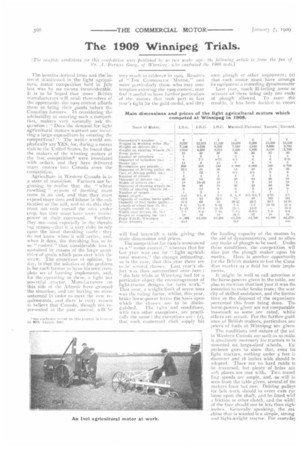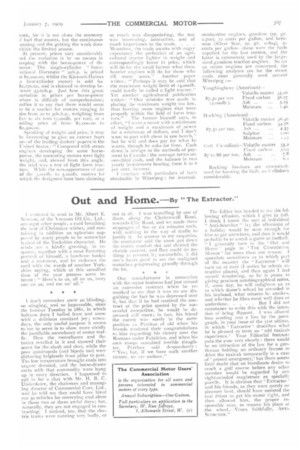The 1909 Winnipeg Trials.
Page 14

Page 15

If you've noticed an error in this article please click here to report it so we can fix it.
The compleL conditions for this romPetil ion were published by /V: two weeks ago : the following article is from the ten of 11-r. A. Burnes.s Grii)Z, of Winniteg. ti ho conefacted the NOS tests.1 The benefits derived from and the interest manifested in the light agricultural motor competition held in July last was by no means inconsiderable. it is to be hoped that more British manufacturers will avail themselves of the opportunity the two contest affords them to bring their goods before the Canadian farmers. In considering the advisability of entering such a competition, makers very naturally ask the question " Does the demand for light agricultural motors warrant our incurring a large expenditure by entering the competition? " The writer would emphatically say YES, for, during a recent visit to the United States, he found that the makers of the winning motors at the last competition* were inundated with orders, and they have delivered many motors into Canada since the competition.
Agriculture in Western Canada is in a state of transition. Farmers are beginning toto realise that the " wheat ranching " system of farming must come to an end, and that they must expend more time and labour in the rul.tiyation of the soil, and to do this they must not only curtail the area under crop, but they must have more motive
power at their command. Further, they see—and especially in the threshing season—that it is very risky to rely upon the hired threshing outfit : they do not know when it will arrive, and, when it does, the threshing has to be so " rushed " that considerable loss is sustained by reason of the large quantities of grain which pass over with the straw. The consensus of opinion, today, is that the solution of the problem is for each farmer toThave his own complete set of farming implements, and, for the operating of these, a light but powerful tractor. Manufacturers on this side of the Atlantic have grasped the situation, and are leaving no stone unturned in order to meet the new requirements, and there is every reason to believe that Canada, though not represented at the past contest, will be 'very much in evidence in song. Readers of "Ti te Ccessmiorei.u. MOTOR," and more particularly those who may contemplate entering the 1909 contest, may find it useful to have further particulars of she motors that took part in last year's light for the gold medal, and they
will find herewith a table giving the main dimensions and prices.
The competition for rgog is announced as a " motor contest,' whereas that for last year was one for " light agricultural motors," the change intimating, as is the case, that this year there are to be several classes. Last year's object was thus summarised over here : " the late trials at Winnipeg had for a particular object the encourages-nent of light-tractor designs for farm work." That year, a weight limit of seven tons was the ruling factor, whilst, this year, brake horse-power forms the basis upon which the classes are to be distin
guished. The rules and conditions, with two other exceptions, are practically the same : the exceptions are : (t), that each contestant shall supply his own plough or other implement; (2) that each motor must have amongs its equipment a recording dynamometer Last year, much ill-feeling arose or account of there being only one maks of plough allowed. To avert this trouble, it has been decided to recor the hauling capacity of the motors b) the aid of dynamometers, and to allow any make of plough to be used. Uncles these conditions, the competition wit also put the plough maker upon hi: merits. Here is another opportunit) for the British makers to test the Cana dian market as a field for their imple. merits.
It might be well to call attention tt the horse-powers given in the table, ant also to mention that last year it was du intention to make brake tests; the scarcity of skilled assistance, and the lirnitec time at the disposal of the organisers prevented this from being done. ThE horse-powers given are not comparable inasmuch as some are rated, whilsi others are actual. For the further guid. anee of British makers, particulars ant prices of fuels at Winnipe,gare given.
The conditions and nature of the soi in Western Canada are such as to makt it absolutely necessary for tractors to be mounted on large-sized wheels. Ex. perience goes to show that, eien Fos light tractors, nothing under 5 feet ir diameter and 18 inches wide should bE adopted. There are no hard roads tc be traversed, but plenty of holes ark soft places are met with. Two travel. ling speeds are ample, and, as will hi seen from the table given, several of the makers have but one. Driving pulley; for belt work should in every case rur loose upon the shaft, and be fitted with a friction or other clutch, and the wida of the face should not be less than eigh inches. Generally speaking, the ma chine that is wanted is a simple, strong and light-weight tractor. For everyda)
vork, for it is not alone the economy ■ 1 fuel that counts, but the continuous uniting and the getting the work done vithin the limited season.
At present, prices vary considerably Ind the variation is by no means in ,teeping with the horse-power of the notor, The single-cylinder " intertational Harvester " 2oh.p. is priced $2,200.00, whilst the Kinnard-I laines a four-cylinder motor) is sold kit p2,27o.00, and is claimed to develop be:ween 55-6oh.p. Just how this great variation in prices per horse-power irises is difficult of comprehension; ;office it to say that there would seem to be a market for motors ranging in size from 20 to 3ob.h.p., weighing from five to six tons (2,000lb. per ton), at a selling price of from $2,000.00 to $2,500.00.
Speaking of weight and price, it may be interesting to give an extract from one of the leading dealers' papers in the United States : " Compared with steam engines developing the same horsepower, the contesting motors were light weight, and, viewed from this angle, the trial was a test of light farm tractors. While the non-appearance of any of the 3,000lb. to 5,000lb. motors for which the designers have been claiming so much was disappointing, the test wa intere,ting, instructive, and of much importance to the trade. . . . Meantime, the trade awaits with eager expectancy the perfection of an agricultural tractor lighter in weight and correspondingly lower in price, which will do for the small farmer what these heavier engines will do for those who till many acres." Another paper writes : " Perhaps it may be said that the maximum weight limit of ne000lb. could hardly be called a light tractor." Yet another agricultural publication writes: " One mistake was made it placing the maximum weight too low, thus; barring some engines that were properly within the field of farm trac tors." The farmer himself says, in effect, "I want a motor with a minimum of weight and a maximum of power for a minimum of dollars, and T don't want to part with these in one bunch,' but he will and does pay for what he wants, though he asks for time. Cash down is foreign to the methods of payment in Canada : the average terms are one-third cash, and the halance in two yearly instalments hearing from 6 to 8 per cent. interest.
1 conclude with particulars of fuels obtainable in Winnipeg, : for internal
combustion engines, gasolene (sp. gr. 0.700), 22 cents per gallon, and kerosene (Silver Star, sp. gr. 0.804), 20 cents per gallon—these were the fuels supplied for the last contest, and the latter is extensively used by the largesized gasolene traction engines. So far as steam engines are concerned, the following analyses are for the steam coals most generally used around Winnipeg :— Rocking fire-bars are extensivele used for burning the Galt, as it clinkers considerably.
























